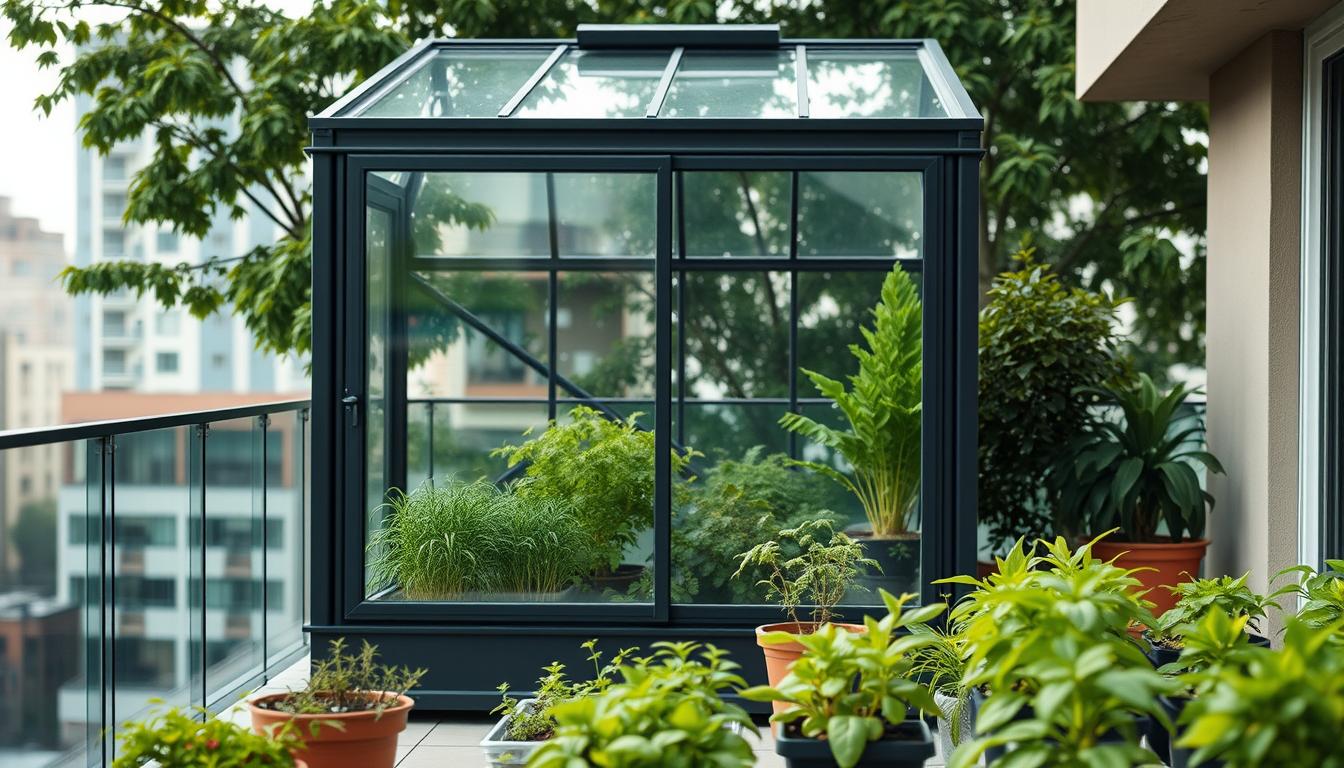Growing your own plants year-round is now possible, even without a big backyard. As someone who loves gardening but has a small balcony, I found amazing small greenhouse options. They fit almost anywhere.
These mini greenhouses are loved by city dwellers and urban gardeners. They want fresh herbs, veggies, and flowers, even with little space. Over three years, I’ve tested many models. I’ve seen how they turn small areas into great places to grow plants.
Even with just a few square feet, you can grow plants all year. You can protect tender plants from bad weather and enjoy fresh produce any time. There’s nothing better than picking tomatoes in December from your patio!
Whether you have a small balcony, patio, or sunny windowsill, there’s a perfect solution for you. Let’s look at how these small growing spaces can change your gardening, no matter where you live.
The Growing Trend of Small Space Gardening
Modern city living has sparked a creative renaissance in small space gardening. Urbanites find clever ways to grow plants in tiny spaces. Apartments get smaller, and outdoor areas are a luxury, yet people still want to grow their own food.
Recent surveys show over 35% of urban households now garden in small spaces. This is a big jump from just 21% a decade ago.
This trend isn’t just about having fresh herbs. For many, these mini gardens boost mental health and environmental awareness. They also give a sense of self-sufficiency in our digital world.
Urban Gardening Challenges
Urban gardeners face big challenges. Tall buildings and neighbors block sunlight, making it hard for plants to grow. Space is limited, forcing tough choices about what to grow.
Weather can also be a problem, destroying plants overnight. Apartment dwellers deal with rules from HOAs and landlords that limit gardening. Balconies have weight limits, and shared spaces don’t allow for permanent gardens.
Year-Round Growing Possibilities
Small greenhouses offer a solution. They create a protected space for plants to thrive, no matter the weather. Indoor greenhouses let you grow plants all year, even in cold climates.
Greenhouses let gardeners grow plants from different zones. For example, Zone 5 gardeners can grow Zone 8 plants. This flexibility has led to a 43% annual growth in the small greenhouse market.
Why Compact Greenhouse Kits Are Game-Changers
For city folks and those with little space, compact greenhouse kits are a game-changer. They turn small areas like balconies and windowsills into places where you can grow plants. These tiny green spaces change what’s possible for gardeners with little room.
Extended Growing Seasons
Compact greenhouse kits let you grow plants longer than usual. They create a warm spot for starting seeds early. You can have fresh tomatoes in spring, even when others are just starting to plant.
They also help grow plants late into fall and winter. In some places, you can grow veggies all year with just a small greenhouse and some heat.
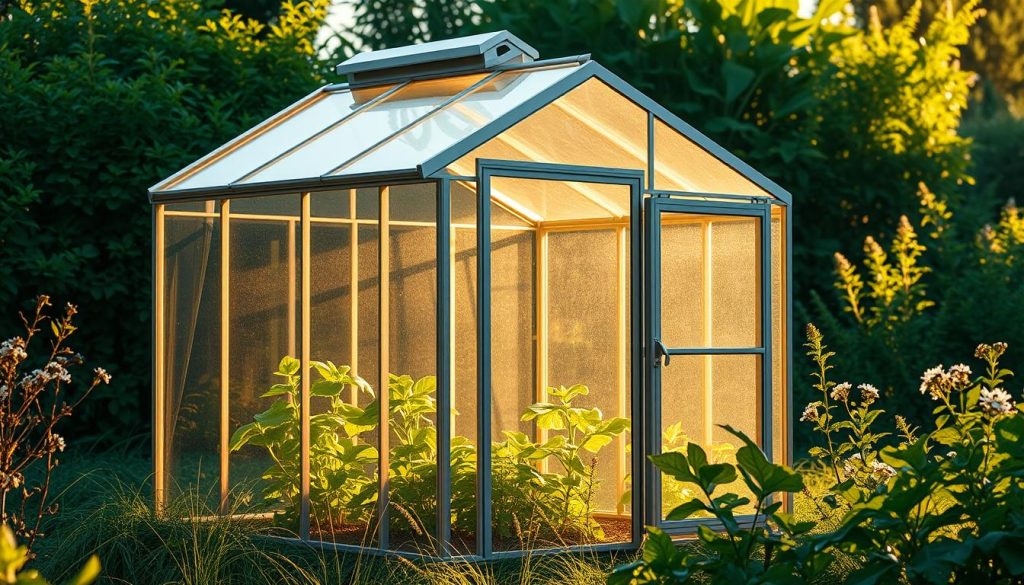
Protection from Weather and Pests
Weather can be tough on gardens. Rain can hurt seedlings, and frost can kill crops fast. Greenhouse kits protect your plants from these dangers, so they can grow well.
They also keep pests away. The greenhouse acts as a barrier, keeping out insects and animals. This means you can grow healthier food without using harmful chemicals.
Controlled Environment Benefits
Compact greenhouse kits let you control the environment for your plants. You can adjust things like temperature and humidity. This is hard to do with outdoor gardening.
This control means you can grow plants that wouldn’t do well in your area. In cold places, you can grow peppers. In hot areas, you can keep plants humid.
Many greenhouse kits are portable. This is great for renters or people who move a lot. You can take your greenhouse with you, so you don’t have to leave your gardening hobby behind.
Types of Compact Greenhouse Kits for Limited Spaces
Today, the market offers special greenhouses for small spaces. You can find one for your balcony, kitchen counter, or sunny window. These greenhouses are designed to fit in tight spots, helping urban and suburban gardeners grow plants.
Mini Walk-In Greenhouses
Mini walk-in greenhouses are small but still offer a full greenhouse experience. They are 4-6 feet wide and deep. This size is perfect for small yards or garden corners.
These greenhouses have adjustable shelves for growing plants up high. You can grow dozens of plants in a tiny space. They have zippered doors for easy access and temperature control. Prices range from $100 to $300, depending on size and quality.
Tabletop and Countertop Models
Tabletop greenhouses are great for tiny spaces, like a square foot. They fit on windowsills, kitchen counters, or small tables. They’re perfect for apartment living.
These greenhouses are great for starting seeds, growing herbs, and keeping small tropical plants. They’re 12-24 inches tall and can hold 6-12 small plants. Prices start at $30, with premium models up to $100.
Window-Mounted Options
Window-mounted greenhouses add growing space without taking up floor space. They attach to windows, using your home’s heat and natural light.
They’re easy to install with basic hardware. They’re perfect for herbs, small flowers, and seedlings. Prices are $50 to $150, depending on size and installation.
Balcony and Patio Solutions
For those with small outdoor areas, there are special greenhouses. You can find lean-to models that attach to walls or collapsible ones for storage. These greenhouses make the most of small spaces.
Unlike grow tents, these outdoor greenhouses use natural sunlight. They’re weatherproof and can be set up without damaging your property. Prices range from $75 to $200, making them great for renters.
Materials and Construction Quality in Compact Greenhouse Kits
Every successful small-space greenhouse starts with the right materials. These materials must be durable, functional, and affordable. The choice of materials for your compact grow room affects plant growth and the greenhouse’s lifespan. Let’s look at the key parts that make up these structures.
Frame Materials: Aluminum vs. Steel vs. Plastic
The frame of your greenhouse is key to its strength and how much it can hold. Each material has its own pros and cons.
Aluminum frames are light, don’t rust easily, and need little upkeep. They’re great for portable or seasonal greenhouses but may not handle extreme weather as well as heavier options.
Steel frames are strong and stable, perfect for greenhouses used all year. But they’re heavy, cost more, and need rust protection in humid places.
Plastic frames are cheap for beginners. They’re light and easy to put together but don’t last long and can warp in strong sun or heavy loads.
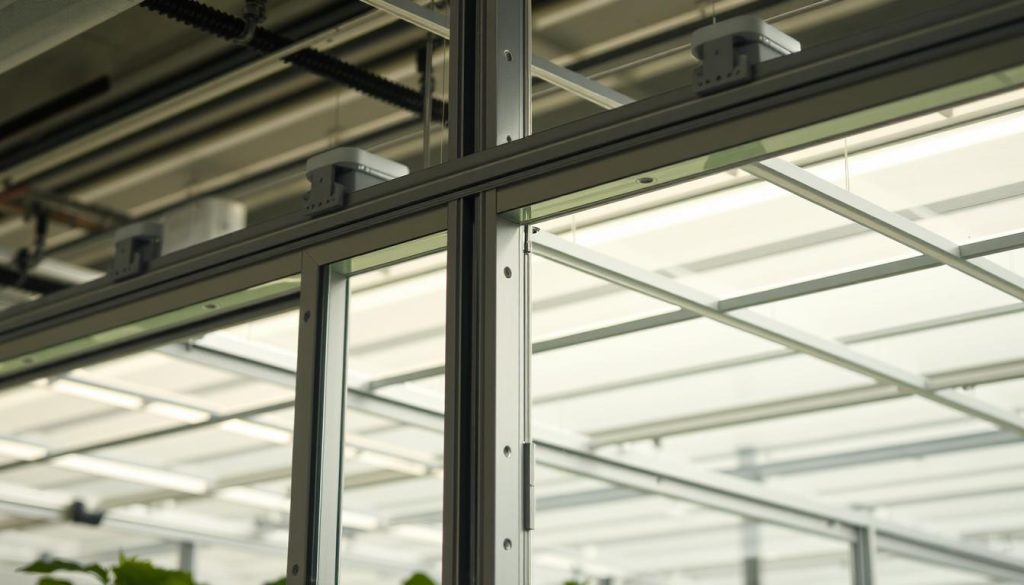
Covering Options: Glass, Polycarbonate, and Polyethylene
The covering material affects how much light gets in, how much heat it keeps, and how well it insulates. These are key for growing plants.
Glass is clear and lasts long. It lets in lots of light and won’t turn yellow. But it’s heavy, can break, and is the most expensive choice for small greenhouses.
Polycarbonate panels keep heat in well and diffuse light to prevent burning plants. They’re tough, light, and protect against UV rays, lasting over 10 years.
Polyethylene film is the cheapest option. It’s light, lets in some light, but needs to be replaced every 1-3 years because it breaks down from UV rays.
Durability and Weather Resistance
Your compact greenhouse must handle whatever the weather brings. Choose materials based on your local weather.
In snowy areas, steep roofs and strong frames prevent collapse. For windy places, solid anchors and heavy frames keep it stable.
In hot climates, good ventilation and UV protection are key to avoid overheating. Coastal areas need materials that resist salt air.
| Material Type | Durability | Cost | Insulation Value | Best For |
|---|---|---|---|---|
| Aluminum Frame + Polycarbonate | High | Medium-High | Good | Year-round growing |
| Steel Frame + Glass | Very High | High | Medium | Permanent installations |
| Plastic Frame + Polyethylene | Low | Low | Poor | Seasonal use |
| Aluminum Frame + Glass | High | High | Medium | Aesthetic priority |
| Steel Frame + Polycarbonate | Very High | Medium-High | Very Good | Harsh weather conditions |
Choosing the Right Compact Greenhouse Kit for Your Needs
Choosing the right compact greenhouse kit starts with knowing what you need. With many options, it’s important to consider a few key factors. These will help you grow plants successfully.
Space Considerations
First, measure the space you have. Don’t forget to include extra room for the greenhouse itself.
Think about door space too. Most greenhouses need 12-18 inches to open. You’ll also need room to get to all sides for upkeep.
If you’re short on space, look for greenhouses with sliding doors. Wall or window attachments are great for tiny areas.
Climate Factors
Your local weather affects your greenhouse choice. In cold areas, choose double-walled panels for better insulation.
In hot places, find greenhouses with good ventilation. Decide if you need it all year or just part of the year.
Strong winds can damage lightweight greenhouses. Make sure they’re anchored well.
Plant Types and Growing Goals
Each plant has its own needs. For starting seeds, small tabletop greenhouses work well.
Tropical plants need tall greenhouses with good temperature control. Hydroponics systems require extra weight support and electricity access.
Think about the plants you’ll grow. Some greenhouses have adjustable shelves for tall plants.
Budget Constraints
Greenhouse kits vary in price, from under $100 to over $500. Knowing what you get at each price helps you choose wisely.
| Price Range | Typical Features | Best For | Expected Lifespan |
|---|---|---|---|
| $50-$100 | Plastic frames, polyethylene covers, basic shelving | Seasonal use, beginners, seed starting | 1-2 years |
| $100-$250 | Reinforced frames, UV-resistant covers, better ventilation | Extended season growing, small hydroponics system | 2-4 years |
| $250-$500 | Aluminum frames, polycarbonate panels, automated vents | Year-round growing, diverse plant collection | 5-10 years |
| $500+ | Premium materials, climate control features, custom sizing | Serious hobbyists, advanced hydroponics systems | 10+ years |
The cheapest option might not be the best value. Better materials mean less need for replacements and better growing conditions.
Setting Up Your Compact Greenhouse: Tips for Success
Setting up your compact greenhouse right from the start saves a lot of trouble. It lays the groundwork for all your gardening success. So, it’s worth spending extra time and attention to detail.
Let’s look at key strategies for a productive growing space, even in small greenhouses.
Location Selection Strategies
Finding the right spot for your greenhouse is key for plant health. Most plants need 6-8 hours of direct sunlight a day. Southern exposure is best in the northern hemisphere.
Morning sun is great because it dries out overnight moisture.
Place your greenhouse away from strong winds. A fence, wall, or hedge can act as a windbreak. This is crucial for lightweight mini greenhouses that can easily get damaged.
Also, choose a spot close to a water source. This saves you from carrying heavy watering cans. For indoor greenhouses, use waterproof mats or trays to protect floors from moisture.
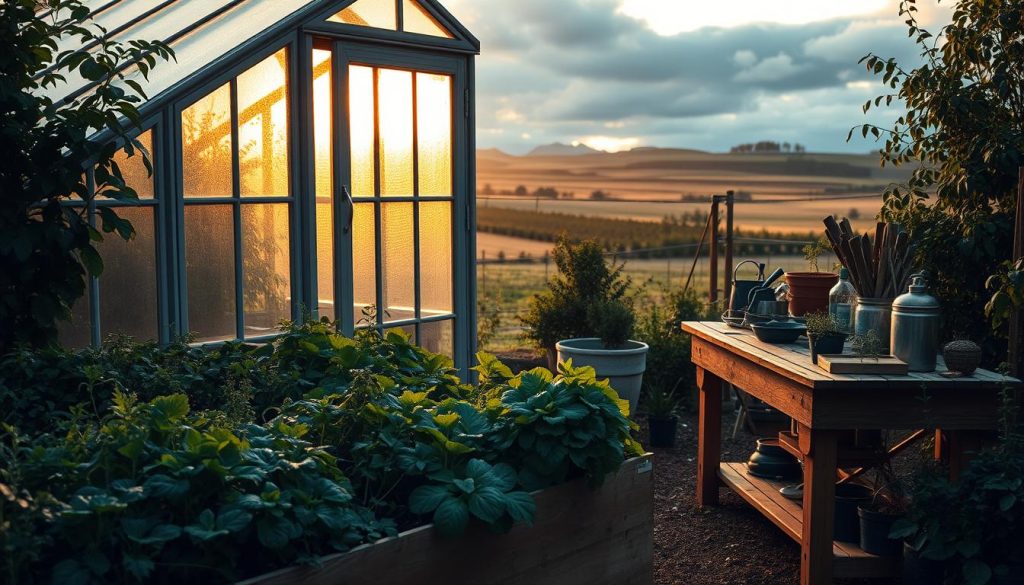
Assembly Best Practices
Before you start, read the instructions carefully and check all parts. Many kits have lots of small parts that can get lost. A cordless drill, rubber mallet, and level are very helpful.
Having someone help you hold panels and stabilize the frame is a good idea. Don’t rush the foundation preparation. Make sure your base is perfectly level, as any tilt can harm the structure.
For outdoor setups, anchoring is crucial. Use ground stakes, weighted bags, or specialized kits to prevent wind damage.
Organizing Your Growing Space
Plan your layout before filling it with plants. Start with seed starter kits in easy-to-reach spots. Install adjustable shelving that can change as plants grow.
Use hanging baskets and wall-mounted planters to save space. Put heavy pots and equipment on lower shelves. Keep tools you use often within reach.
Set up zones for different plants based on their needs. Even in small indoor greenhouses, clear paths help avoid damage and make care easier. An organized space from the start boosts your growing capacity.
Maximizing Growing Capacity in Small Greenhouse Spaces
Small greenhouses can be very productive with the right planning. Even tiny spaces can grow a lot of plants. Let’s look at ways to use every inch of your greenhouse.
Vertical Growing Techniques
Vertical growing turns your greenhouse into a three-dimensional space. Use trellises and planters to let plants grow up. This way, plants like cucumbers and tomatoes use less space.
An A-frame trellis can hold many plants without taking up much room. Ceiling strings are great for tomatoes. These ideas can make your growing area three times bigger without needing more space.
Multi-Tiered Shelving Systems
Shelving is a smart way to increase your growing space. Choose shelves that are sturdy, adjustable, and let light through.
Wire shelving is good because it lets light reach plants below. Put taller plants on lower shelves and shorter ones above. This is a trick used in grow tents too, making the most of small spaces.
Hanging and Wall-Mounted Options
Don’t forget about your greenhouse’s walls and ceiling. They’re great for hanging baskets and wall planters. These save floor space.
These options are perfect for growing new plants. A single wall can hold dozens of seedlings, just like a few potted plants.
Succession Planting Strategies
Using space well isn’t just about how you arrange things. It’s also about when you plant. Succession planting means you always have something growing. This way, you don’t waste time or space.
| Month | Early Season | Mid-Season | Late Season |
|---|---|---|---|
| Spring | Lettuce & Radishes | Seedling Propagation | Summer Transplants |
| Summer | Tomatoes & Peppers | Herbs & Greens | Fall Seedlings |
| Fall | Cold-Hardy Greens | Root Vegetables | Winter Herbs |
| Winter | Microgreens | Early Spring Seeds | Overwintering Plants |
By using these methods, your small greenhouse can be very productive. The ideas from grow tents work well here too. With careful planning, your greenhouse can be incredibly productive, even with limited space.
My Top Recommendations for Compact Greenhouse Kits
I’ve looked at many options and picked the best compact greenhouse kits for small spaces. These kits have been tested and loved by gardeners in different conditions. They’re perfect for small gardens.
Best Budget-Friendly Options
The Ohuhu Mini Portable Greenhouse is great for those on a budget. It has 4-tier shelving and a roll-up door. It’s perfect for starting seeds and protecting plants without spending a lot.
The Gardman 4-Tier Mini Greenhouse is even more compact. It’s great for balconies and small patios. It’s easy to set up, but make sure it’s secure in windy weather.
The Quictent Mini Walk-in Greenhouse is a bit more expensive but worth it. It has a durable steel frame and a strong PE cover. It’s small but has enough room for several projects.
Premium Choices Worth the Investment
The Palram Harmony Small Greenhouse is a top choice for its price. It has a rust-resistant aluminum frame and strong polycarbonate panels. It’s well-insulated and has a roof vent for year-round use.
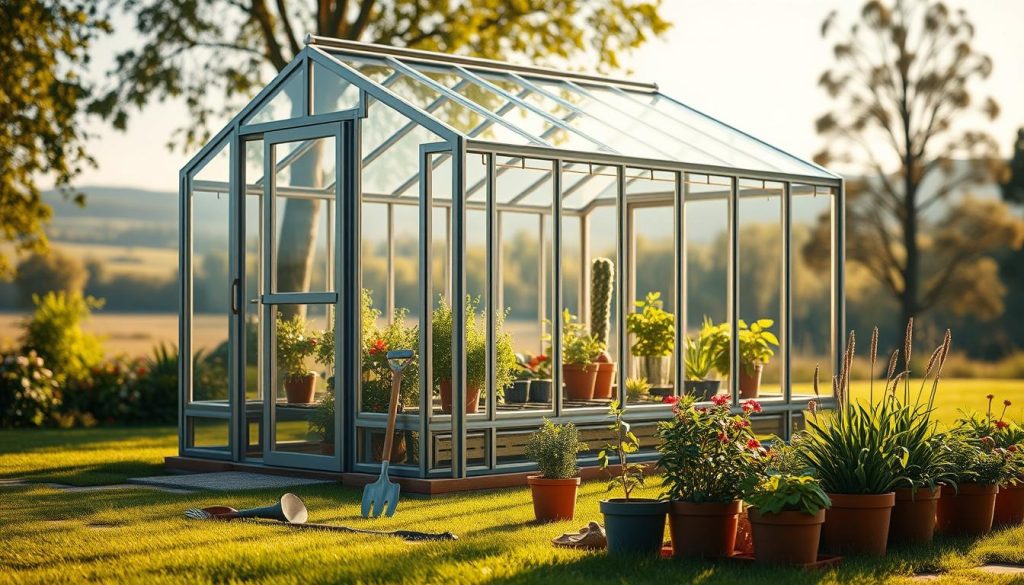
The Sungrow Mini Greenhouse is for serious growers. It has automated ventilation, humidity control, and is very weather-resistant. Its design can be expanded as needed.
Ideal Kits for Specific Growing Needs
The Gardener’s Supply Company Compact SeedHouse is perfect for starting seeds. It has a heat-retention design and humidity dome. It’s great for starting many seedlings.
The Exaco Eco-Grow Greenhouse is great for growing vegetables all year. It has special shelves and optional drip irrigation. Its panels keep plants warm in cold weather.
The Bio Green Portable Greenhouse is ideal for tropical plants. It keeps humidity high and has an optional heating mat. It’s perfect for plants that need a warm environment.
Most Versatile All-Season Options
The Flower House SpringHouse is very versatile. It has a pop-up design that can be easily set up or stored. Its PVC covering lets in light and protects plants.
The Palram Plant Inn is very adaptable. It has adjustable roof panels, removable beds, and modular shelving. It’s small but has a lot of growing space.
These options cover different needs and budgets. The best greenhouse for you depends on your space, climate, and growing goals. Choose one that fits your needs and budget for the perfect growing space.
Cost-Effectiveness and ROI of Small Space Greenhouse Gardening
Small space greenhouse gardening is a smart choice. It starts with a cost but then saves money over time. Knowing the financial side helps gardeners make smart choices and set realistic goals.
Initial Investment vs. Long-Term Savings
Starting a small greenhouse costs more than just the structure. You’ll need growing media, containers, tools, and maybe irrigation. But these costs often pay off in the long run.
A good compact greenhouse kit costs $100-$500, based on size and materials. Adding supplies like growing media can add another $50-$200.
Long-term, you save money on groceries, plant replacements, and grow longer seasons. This makes your investment worth it.
| Greenhouse Type | Initial Investment | Annual Savings | Payback Period |
|---|---|---|---|
| Mini Walk-In (4×6 ft) | $300-450 | $200-300 | 1.5-2 years |
| Tabletop Model | $80-150 | $75-125 | 1-1.5 years |
| Window-Mounted | $120-200 | $100-150 | 1-1.5 years |
| Hydroponics System | $250-500 | $300-450 | 10-14 months |
Produce Yield Expectations
Small greenhouses can surprise you with their output. Even in tight spaces, smart planting can lead to big harvests.
A 4×4 foot greenhouse can grow 20-30 pounds of tomatoes a season. A small hydroponics system in the same space can yield 3-5 pounds of greens weekly, all year. This beats traditional soil methods in small spaces.
Using vertical growing can boost yields by 30-50%. This makes even the smallest greenhouses very productive.
Energy Efficiency Considerations
When calculating ROI, operating costs are key. Heating and cooling can add costs, but smart design can cut these down.
Using passive solar design can reduce or eliminate heating needs in many places. Adding thermal mass, like water jugs, can store heat for cooler nights.
In colder areas, a small hydroponics system is often more energy-efficient than soil. These systems use 90% less water and need little extra light in a well-placed greenhouse.
The best approach mixes seasonal changes with the right crops for your area. This way, you get the most from your investment while using less energy.
Transform Your Small Space with the Perfect Greenhouse Solution
Small spaces can be perfect for gardening all year round. Even a tiny balcony or a corner of your apartment can become a garden oasis. The right setup makes it happen.
Compact greenhouse gardening is easy to start. You don’t need a lot of land or perfect weather to grow plants. A mini greenhouse protects plants from bad weather.
Start small with seed starter kits and a tabletop greenhouse. They need little space and teach you about growing plants indoors.
Last winter, I grew fresh basil and lettuce on my balcony. It was amazing to pick them while it snowed outside. It changed how I see gardening and food.
Ready to start your greenhouse journey? Look at your space and decide what plants you want to grow. Choose a solution that fits your needs. You can pick from window units, countertop greenhouses, or small walk-in ones.
The best part of small-space greenhouse gardening is the creativity and connection it brings. Your perfect greenhouse solution is waiting. It will turn your small space into a productive garden that brings joy all year.

